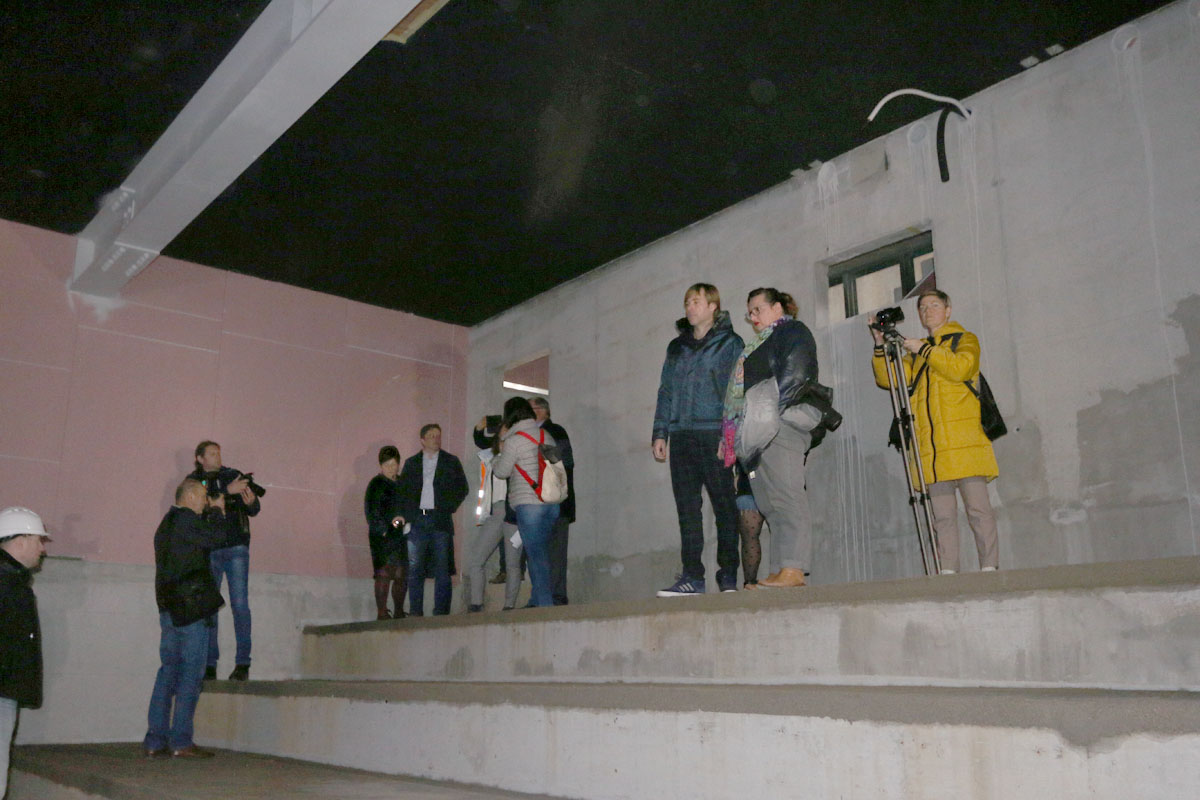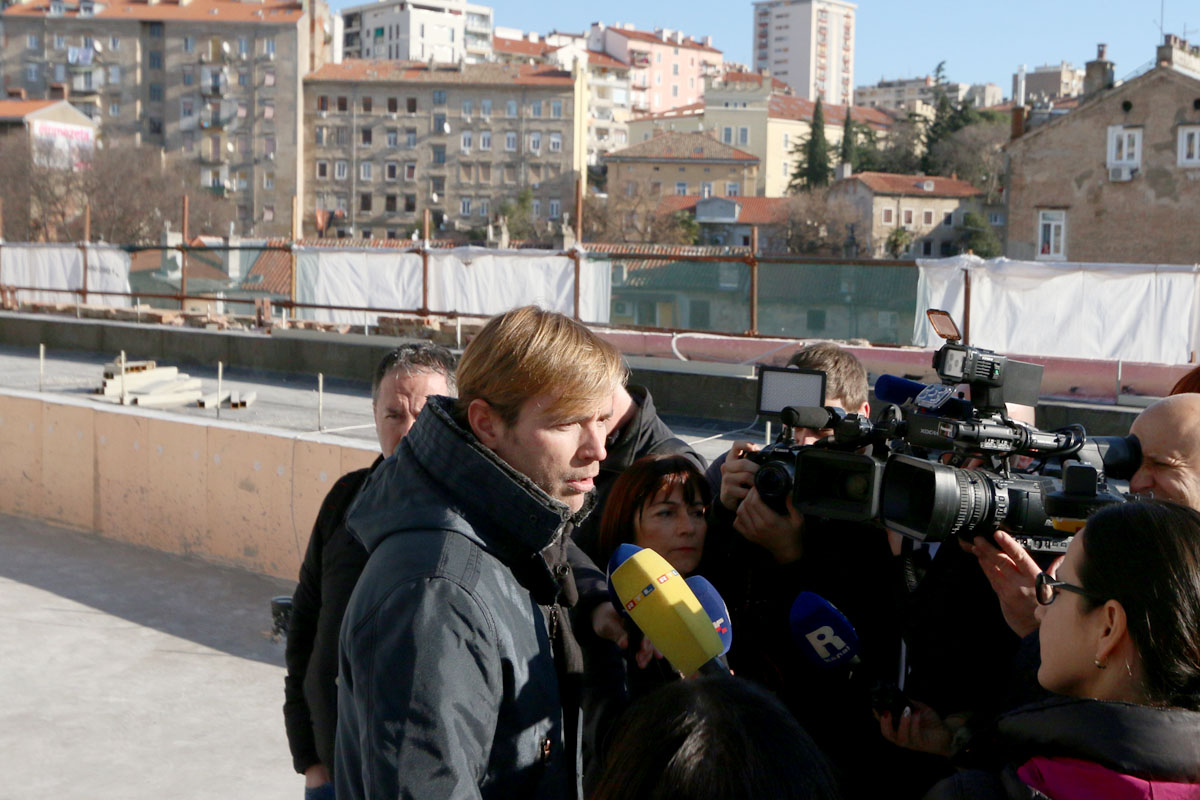The Children’s House that is being constructed as part of the European Capital of Culture project is undergoing final construction works before it enters the interior furnishing phase. During a tour of the construction site on 13 January at the former Rikard Benčić industrial complex, representatives of the city of Rijeka, RIJEKA 2020 and reporters were briefed about the current state of what will become the Children’s House, the first ever multifunctional location of its kind in Croatia.
The tour was attended by the Mayor of Rijeka Vojko Obersnel, the President of Rijeka City Council Andrej Poropat, Heads of the Culture and Utility Services Departments Ivan Šarar and Irena Miličević, the CEO of RIJEKA 2020 and the Head of the “Children’s House” flagship Emina Višnić and Jelena Milić, on behalf of the constructor ING-GRAD d.o.o., Construction Site Manager Borna Večenaj and Head Construction Works Supervisor Zrinka Brkić from ZEM nadzor d.o.o..
All the construction works on the building are now completed, and they included securing the structure of the Brick Building, assembling the load-bearing and partition columns, concreting the floor structures and the roof panel, the assembly of the mezzanine of the 4th floor, window installation preparatory works, steel facade gratings, and the finishing and painting of the ceilings inside the house.
Currently, craft work is in progress on all floors, along with the finishing of the reinforced concrete walls, assembly of the secondary framing for the partition walls, the fire-resistant coating of the steel construction, thermal insulation of the floor structures, making cement screeds for the floor structures, the preparation of suspension for the electrical, water supply and sewage installations, and preparations for mechanical installations.
Construction will end with the installation of exterior joinery, the construction of a portion of the roof above the steel structure of the 4th floor, and the restoration of a section of the front façade of the building.
According to Zrinka Brkić, Head Construction Works Supervisor, most of the problems in the reconstruction of the building were caused by groundwater and high rainfall, but these setbacks had little actual effect on the planned schedule, meaning that the construction and craft works will soon be finalised.
“Ever since contractors entered the facility in March of last year, nobody dared to believe that the works would progress at such a fast pace, and it can be expected that the Children’s House will be opened in June, as planned,” said the Mayor of Rijeka Vojko Obersnel on the occasion, adding that this one-of-a-kind Croatian project will fit in perfectly with Rijeka’s art neighbourhood that found its place inside the Benčić complex.
The Head of the City’s Department of Culture, Ivan Šarar, expressed his satisfaction in these words:
“Of all the things we are doing, the Children’s House gives me the most joy, it is ‘everyone’s favourite’ part of the Benčić neighbourhood. While the City Library and museums are typical cultural institutions, the Children’s House is an adventure and none of us are completely sure what it is will look like once it opens,” said Šarar, adding that the future children’s cultural hub will house three cultural institutions – Art Kino, the Rijeka City Library, and the Rijeka City Puppet Theatre with their partners.
Noting that these institutions offer extensive children’s programmes even as we speak, Šarar mentioned the fact that the stronger infrastructural support will foster the further development of the said programmes, and he added that for children, growing up in Rijeka will undoubtedly reach new heights of quality.
Among other activities surrounding the upcoming programme and infrastructural segment of the Rijeka 2020 – European Capital of Culture project, the opening of the Rijeka City Museum at the Sugar Refinery Palace was announced for April of 2020. This building of the former Benčić complex is currently being furnished, while all the construction works have been finalised.
Moreover, Mayor Obersnel announced a spectacular opening ceremony of the European Capital of Culture programme on 1 February in the Port of Rijeka, stating that the programme will consist of many elements, such as a dedication to the industrial history of Rijeka in the form of an opera, a big fireworks show, and a surprise that is still being kept under wraps, to name but a few.

Children’s House – the future hub of children’s cultural activities
The content of the Children’s House will be intended for the age group ranging from 0 to 12, while the programmes will feature much more than just content that can be watched, listened to or read, as the children themselves will get the chance to create, devise, share and receive the cultural activities being implemented there. All of this is aimed at fostering their creativity in an interactive manner.
Some of the activities envisioned for this hub of children’s culture in the making include creating animated movies in a movie studio, making video reports, creating music in a music studio, playing video games on the big screen of the screening hall, creating video games, product design and 3D printing, storytelling theatre in the small amphitheatre on the roof of the house, “sweet“ interactive baby theatre, doll-making, “sensory“ theatre for children with a special emphasis on working with children with developmental disabilities, customised movie screenings for children with developmental disabilities, daily movie screenings for children, the playroom at the library etc. and more.
This HRK 162123324.61 million redevelopment project is part of the project entitled Revitalisation of the Benčić Complex – the Brick and the T-shaped Buildings. The City of Rijeka has received EU funding for this project in the form of a grant amounting to HRK 68206564 million. The remaining part of the investment is financed by the City of Rijeka in the form of a loan share amounting to HRK 98706500 and by funds from the EU Projects Co-financing Fund amounting to HRK 10 million. The construction works began on March 11, upon the signing of the contract with ING-GRAD construction company in January 2019. The works on the Children’s House amounting to HRK 43.4 million are carried out by the Zagreb-based construction company ING – GRAD, while the construction work supervision services, amounting to HRK 319,000, are provided by ZEM nadzor d.o.o. It is estimated that the furnishing of the Children’s House will cost HRK 8.2 million.
The Brick Building was constructed at the end of the 19th century as part of the then Royal Hungarian Tobacco Factory on the site of two older buildings. According to a map of the complex from the year 1875, there were two smaller buildings on the site of today’s Brick Building, one of which was used as a water mill on the Brajda brook. Originally, it was connected by bridges to the H-shaped Building on the southern side, and to the now-demolished building on the north-eastern side. After the end of World War II, the Brick Building became part of the newly-formed “Rikard Benčić” Factory of Motor Machines and it was abandoned after the demise of the factory in the 1990s. Its architectural and historical merit lies in the fact that it is an example of industrial architecture from the late 19th century and of the typology of warehouse buildings of the time.

Along with the renovation of the Brick Building / Children’s House within the former Rikard Benčić industrial complex, Rijeka’s first ever art neighbourhood will also include the soon to be Rijeka City Museum in what used to be the Sugar Refinery Palace, the new headquarters of the Rijeka City Library in what used to be the “T-shaped Building”, and the already open Museum of Modern and Contemporary Art in the former “H-shaped Building”. Infrastructure construction and landscaping works are also well underway on 15700 square metres of public spaces. The total investments into the former industrial complex amount to HRK 250 million.

